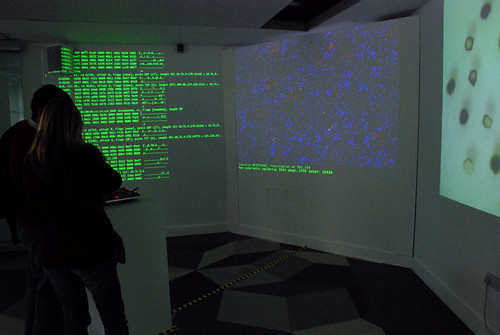Cybernetic Bacteria 2.0 was part of the exhibition INFECTIOUS in Dublin’s Science Gallery. This exhibition explored “mechanisms of contagion and strategies of containment through a range of exhibits, experiments and epidemic simulation.” [1]
Cybernetic Bacteria 2.0 is also a part of Anna Dumitriu’s project Normal Flora, which is her own major ongoing art project about “our sublime microbial world.” [2] She wishes to make clear the way in which we co-exist with millions upon millions of bacteria and microbes, which we encounter in everyday life. Not all of them are harmful, and Normal Flora wishes to show that bacteria are as much a part of our eco-system and not as disgusting as is usually thought.
The artwork is based upon two forms of communication: bacterial and digital. Bacteria communicate in a very dense, complex and continuous way, using air-born forms to communicate with their environment. Similarly, digital communications follow this same pattern, being dense, complex and also continuous, ongoing without an end. Dumitriu et al. decided to combine these two forms of communication to create a ‘new’ artificial life form, a life form able to use the bacterial and digital communications to its advantage. They wish to explore “the layers of complexity in both digital and organic communications networks and [investigate] the relationship of bacteria to artificial life.” [3]
A device is placed in front of the installation, which registers any form of live data stream in its vicinity. Our mobile phone devices, Bluetooth, wireless and RFID activity are all picked up by this electronic device and translated into data. Similarly, communication activity between bacteria (most likely a fixed recording, though no clear information is given about this) is also picked up and translated into data.
Both forms of data are then inserted into a specifically written computer programme, created by Lorenzo Grespan. This computer programme uses the communication data from both forms – bacterial and digital – to generate an artificial life form, a life form with access not only to our biological origins (after all, are bacteria not an important aspect of our own lives?) but also to our entire communications network. The computer manages to create a “chimeric life form” able to “subvert both biology and technology.” [4]
Thus, the primary question of Cybernetic Bacteria 2.0 can be formulated as “[w]hat would a creature with access to humanity’s digital knowledge, the genetic toolbox that drives evolution; the sophistication of the pathogen; and awareness of all our intimate vulnerabilities do?” [5]

Cybernetic Bacteria 2.0 can be compared to Eduardo Kac’s Genesis [6], since both Kac and Dimitriu et al. use bacteria and biological processes to create a new sort of organism, triggered by audience interference. There is one major difference between Cybernetic Bacteria 2.0 and Genesis, however. The processes in Genesis enable an entirely new life form to be created, one that actually exists. Cybernetic Bacteria 2.0 only creates a computer generated life-form, a life form that is only theoretical, and not ‘real’.
(Though, were Dimitriu et al. to create a ‘real’ life form with access to both digital and biological knowledge, there would probably be all sorts of ethical issues raised not beneficial for the piece of art.)
Nam June Paik stated that “cybernetics is the exploration of the boundary regions between and across various existing sciences.” [7] Cybernetic Bacteria 2.0 is a perfect example of inhabiting these boundary regions, since it is no longer just biology or bacterial studies, nor is it communicational sciences, nor is it computer sciences. It is a combination of all of these, creating an interactive and fascinating art piece, a piece of art that is lifted far above the sum of its separate (scientific) elements.
Sources:
[1] Green, Jo-Anne. ‘Live Stage: Cybernetic Bacteria 2.0’. Networked Performance Blog. Retrieved from http://turbulence.org/blog/2009/04/13/live-stage-cybernetic-bacteria-20-dublin/
[2] ‘Introduction’. The Normal Flora Project. Retrieved from http://web.mac.com/annadumitriu/NF/Home.html
[3] [4] ‘Cybernetic Bacteria 2.0’. The Normal Flora Project. Retrieved from http://web.mac.com/annadumitriu/NF/Cybernetic_Bacteria_2.0.html
[5] Green, Jo-Anne. ‘Live Stage: Cybernetic Bacteria 2.0’. Networked Performance Blog. Retrieved from http://turbulence.org/blog/2009/04/13/live-stage-cybernetic-bacteria-20-dublin/
[6] As found in Shanken, Edward. Art and Electronic Media. London: Phaidon, 2009: pp158
[7] Paik, Nam June. Cybernated Art. As found in Shanken, Edward. Art and Electronic Media. London: Phaidon, 2009: pp198
